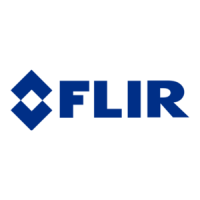16.3 Typical field investigations
16.3.1 Guidelines
As will be noted in subsequent sections there are a number of general guidelines the
user should take heed of when carrying out building thermography inspection. This
section gives a summary of these guidelines.
16.3.1.1 General guidelines
■ The emissivity of the majority of building materials fall between 0.85 and 0.95.
Setting the emissivity value in the camera to 0.90 can be regarded as a good
starting point.
■ An infrared inspection alone should never be used as a decision point for further
actions. Always verify suspicions and findings using other methods, such as con-
struction drawings, moisture meters, humidity & temperature datalogging, tracer
gas testing etc.
■ Change level and span to thermally tune the infrared image and reveal more details.
The figure below shows the difference between a thermally untuned and a thermally
tuned infrared image.
10552103;a2
Figure 16.1 LEFT: A thermally untuned infrared image; RIGHT: A thermally tuned infrared image, after
having changed level and span.
16.3.1.2 Guidelines for moisture detection, mold detection & detection of
water damages
■ Building defects related to moisture and water damages may only show up when
heat has been applied to the surface, e.g. from the sun.
■ The presence of water changes the thermal conductivity and the thermal mass of
the building material. It may also change the surface temperature of building mate-
rial due to evaporative cooling. Thermal conductivity is a material’s ability to conduct
heat, while thermal mass is its ability to store heat.
Publ. No. T559580 Rev. a486 – ENGLISH (EN) – November 17, 2010 49
16 – Introduction to building thermography

